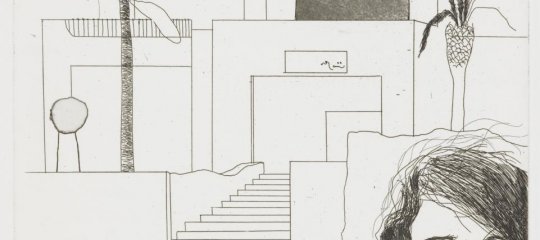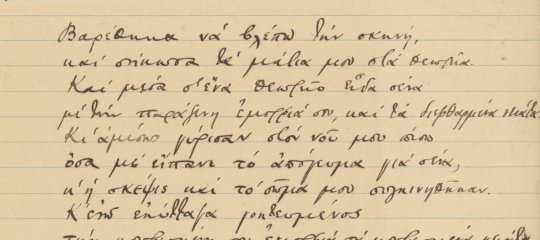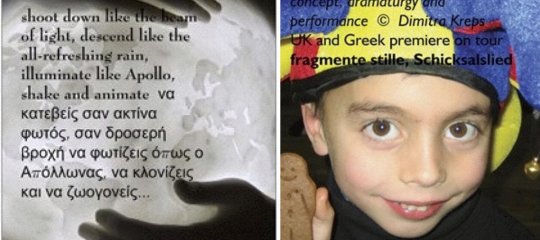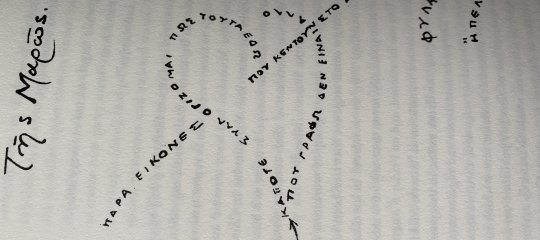Introduction to Modern Greek Literature (Seferis)
tzanidaki writes, "Lecturer: Dr Dimitra Tzanidaki-Kreps
University of Reading, Department of Classics
"
22 Απριλίου 2008
Examine the formal and thematic constituents of Seferis’ poetry with particular reference to his ‘mythical’ and ‘allusive’ method.
By James Stewart, Classics, 2nd year student
George Seferis’ poetry is rich in metaphorical and semantic meanings that often present a rather bleak and desolate image of life and society. Many say that he is similar in style to T.S Eliot and having read ‘The Wasteland’ and a lot of Seferis’ poetry I would have to agree. The alienation that Seferis addresses, be it alienation brought about through war or exile, is very similar to the alienation we see Eliot present through his characters that find themselves lost in a large city full of capitalism and consumerism. Seferis is also very widely read in ancient Greek literature and he uses his knowledge of these texts, to further expand his modern views. An important point to make is however, is that Seferis is able to use ancient ideas and embed them into his own work yet still make his poetry timeless and applicable to readers today. Even whilst a lot of the poetry reflects ongoing issues of up to seventy years ago, one can read his poetry now and relate to it.
‘Last Stop’ is a poem with many metaphorical connotations about war and the destruction that is created by it. Seferis cleverly uses repetition to emphasise the futility of war, and suggests that war is often a money making opportunity for the politicians that manipulate countries, ‘the chest of a miser…’ The financial causes behind war are what Seferis suggests are the reasons for the delay of many to return home after war and this is due to their financial interests as they wish to line their pockets from deceitful wars and at the cost of others suffering . The opening and closing lines of the poem are identical ‘few are the moonlit nights that I’ve cared for.’ This appears to complement the poem visually and technically, creating a carefully crafted piece of verse that is acoustically astute, however this is not its only function. The moon works as metaphor to represent the propaganda that Greece was clearly exposed to throughout the Second World War. The moon covers the stars and thus in metaphorical terms, deceives man of truth and reality. We see Seferis using such techniques in one of his early works ‘Fog’. Here he uses the fog to portray the propaganda and lies that cover everyday reality. The ‘condensed mist’ appears to blanket man in a sense of comfort yet hides him from the truth and thus works negatively. In the case of the moon in ‘Last Stop’, we can interpret it as the expression of the poet’s distress at the vulnerability of man to the fraud and injustice associated with war .There appears to be a strong negativity that accompanies a rather sombre representation of war. Even the hero seems to be misled and is left with no real sense of direction or meaning as we shall see. However, it is through the use of natural images such as the moon, working to highlight and uncover the betrayal and deception that man is exposed to, that I wish to progress.
Helen, another of Seferis’ poems again features similar motifs as ‘Last Stop’ and evokes similar ideas about war and its futility. The repetition of the nightingales emphasises once again the cyclical nature of Seferis’ poetry, drawing on ideas of life’s futility and ever impending fate. Once again Seferis uses a visually beautiful image, in this case a nightingale as a means to emphasise metaphorically the cyclical journey of life. We bare witness to the moon working as a means to obscure reality and in this instance we see the moon blotting out the archer’s sight of his target and thus causing him to miss, ‘my fate, that of a man who missed his target.’ Seferis cleverly uses an unknown yet visually wonderful object, such as the moon to carry ideas of deception and the unknown and it works brilliantly in both ‘Last Stop’, and ‘Helen’. When the poems were published very little was known about the moon, and even in the present day, there are still mysteries surrounding it. By using the moon therefore, to convey deceit, the reader is left with what I feel a very clear idea of the disillusionment that Seferis felt accompanied soldiers in war.
Seferis’ poetry is created through wonderfully crafted use of ancient literature, that both emphasises Seferis’ abundance of literary knowledge, and his ability to remove from his poetry any restrictions involving time, thus creating poetry that is in essence both timeless and universal. ‘Helen’ is a prime example of this, as Seferis uses the premise of Euripides’ tragedy ‘Helen’, alluding to the situation in Cyprus where men were fighting in vain and for futile causes. In the Euripidian play, the Trojan War is fought over a non entity, ‘What? You mean it was only for a cloud that we struggled so much?’ The fact that the men were deceived into believing that Helen was at Troy interests Seferis who can draw parallels into the modern conflict he wishes to comment upon. He sees similarities not only between the Trojan War and the Second World War, but also he sees a continuing theme that is universal and stays current throughout time. Seferis is able to understand the misperception that humankind have, be it a flaw or not, and believes the hardships humankind suffer is often for nothing, ‘what’s this? Then did we toil in vain there simply for a cloud?’ The poem is surrounding in mystery, and this is a purposeful ploy of Seferis: Helen is the phantom, and the reactions and repercussions she causes are relevant in her time yet echoes throughout the ages. Seferis cleverly keeps the mystery in her character by describing her very vaguely, ‘on shoulders, thighs and knees’ By not giving her any specific and personal traits or character foibles, Seferis is very cleverly able to make her aloof, very much surrounded in mystery and this echoes his portrayal of the moon and its obscurity.
Subtle anachronisms are common in Seferis’ work. In ‘Helen’, Teucer and Platres are juxtaposed, and Seferis suggests that Teucer went to Platres which is not the case. Seferis’ ability therefore to remove historical events from there time period, especially in this poem, thus makes the events timeless as I have previously discussed. This technique can be seen in ’upon a foreign verse’ where Odysseus is associated with a practice that non existent in his time, and in fact created much later . This technique I feel was used to reach out to Modern Greek audiences and give them something wonderful and timeless that they could address as being part of their history. Seferis had a great ability through this technique in making Greeks realise the continuation of their once great and all powerful civilisation. This would have given great hope to those involved in war and the deterioration of Greek society especially during the revolution. Whilst we can say that Seferis wants his Greeks to be proud of there ancestral roots, his hero in ‘Helen’ sympathises not only with the Greeks, but with all people, both Greeks and Trojans. As the poem progresses, the idea of sympathy for all humankind is intensified, ‘in future years some other Teucer, or some Ajax or Priam’, and we are no longer left with the idea of siding with one party in a war, yet we are rather left with the idea that anyone can fight for ‘an empty tunic’, a lost cause. By having opposing sides mentioned in the same breath, (in this instance Priam and Ajax) Seferis is able to break any boundaries that separate people, and reach out to everyone, depicting the deception that accompanies war. The poem ‘Helen’ can therefore be seen as an allegory to represent that war was supposed to create, freedom and democracy. Yet in both reality and the poem, these ideals never materialise and we are left with a very bitter and bloody war all for conceited lies. Helen (the character) can be seen to portray the betrayal Cypriots received and the non entity Seferis believed they fought for . In ‘Salamis of Cyprus’ Seferis has a similar view that he expresses, talking of a broken dream that those living in Cyprus had, and he goes further to discuss how the dreams they fought for have never been realised.
One thing that can be said about Seferis’ poetry is that it is not easy to isolate the tragedy of war from the tragedy of human existence . Certainly war is the central theme in a lot of his poetry and it brings with it, and portrays the frailties and weaknesses of man. In other words, war is the outcome of man’s inner evils and thus Seferis, whilst commenting on the negative effects of war upon humankind and sympathising with them, does believe that it is humankinds own fault that they have reached the predicament they face. In ‘Last Stop’, a key poem on the subject of war, Seferis suggests that it is the destruction of individual human beings that causes war and as a result there faults and evil work on a much larger scale, affecting the innocent. In ‘Last Stop’ man is said to be ‘soft, a bundle of grass’ and ‘insatiable’ . Man is represented therefore as having many weaknesses and vulnerable to being seduced into a life of evil. Therefore one can interpret the moon once more as a higher more spiritual being (a Lucifer) that is able to lure man into war and a path of destruction and turmoil. The grass allusion suggests metaphorically that man is vulnerable and with his nerves spreading like roots, he is at the mercy of corruption, and propaganda.
Continuing the theme of man’s vulnerability to corruption and evil, Seferis introduces the fallen hero in Michael. The character Michael echoes the work of a Greek writer named Costas Karyotakis, who in his work ‘Elegies and Satires’ writes of a fallen war veteran who discharges himself from hospital and with his wounds still open, walks the streets in agony, moaning. Seferis uses his knowledge of literature once again here. We have seen already how Seferis uses other works of literature so to introduce and address issues of importance to him and others, and here is no different. He uses Michael and his foot to enrich his text academically and to explore ideas of heroism. The hero going forward into darkness implies that the war leads nowhere and that the heroes of war, who return home, expecting a changed and better life, end up like poor Michael, wandering the streets still carrying their battle scars.
Nostos (homecoming) has been explored throughout Greek literature from as early as Homer 7th century B.C. ‘The Odyssey’ tells the story of Odysseus’ attempt to return home and return order to an island in anarchy. Seferis’ poem ‘The Return of the Exile’, demonstrates a merging of present with past, yet unlike the ancient Homeric text, Seferis presents the return in a negative way. There is no question of marital recognition, yet we see the failed ‘recognition’ of the homeland. When the exile returns he is not instantly able to get everything back on track with his life and we see him becoming distant from his friend as the friends voice seems to drift away. The return to normality and the same is only an ideal in Seferis’ poem here and as Seferis was an exile himself, I’m sure his poetry echoes his own feelings. By using the motifs of Homer, Seferis enriches the text for those who have background knowledge in ancient Greek texts such as the Oresteia and ‘The Odyssey’ which also deal with the issue of nostos. Seferis uses well known motifs in order to comment upon political issues of the time. ‘He (sc. Seferis) lives with the emotional life of the poetic texts he loves, and searches for an equally live presence in his own poetry and the Greece of his own day.’ Whilst nostos was fulfilled in ancient Greek literature, Seferis uses ancient motifs to convey the unfulfillment of homecoming in the modern day, and this is very powerful.
Through motifs and literary knowledge and finesse, Seferis is able to make his poetry speak volumes to myself and therefore most certainly the Greeks who can relate and understand all the problems and issues he raises. Seferis’ poetry is technically very good, with appropriate use of ring composition, repetition and imagery. Yet it is most certainly more than just this. Seferis’ poem ‘Last Stop’ contains a passion that only a writer who really understood what he was writing about could produce, and it is through this that his allusive and mythical methods and techniques flourish. His ability to make his poetry appear timeless and appeal to more than just Greek audiences is due to his great understanding of how to include ancient texts and make them relevant to his own ideas. Whilst this is a very difficult thing to do, when it is mastered, it can create brilliant literature.
Bibliography
George Seferis Complete Poems , Edmund Keeley (Translator), Philip Sherrard (Translator) Anvil Press Poetry; New Ed edition (Oct 1993)
C.Capri- Karka War in the Poetry of George Seferis Pella Publishing,U.S. (Jan 1998)
Costas Karyotakis Elegies and satires translated by Peter J. King and Andrea Christofidou (1927).
Roderick Beaton George Seferis. 1991 Bristol classical press
Kolokes: A Study of George Seferis' Logbook III (1953-1955) Adolf M Hakkert (Mar 1995)
C. Capri-Karka. Love and the symbolic journey in the Poetry of Cavafy, Eliot and Seferis. 1982.
http://nobelprize.org/nobel_prizes/literature/laureates/1963/seferis-bio...
- Εισέλθετε στο σύστημα για να υποβάλετε σχόλια










